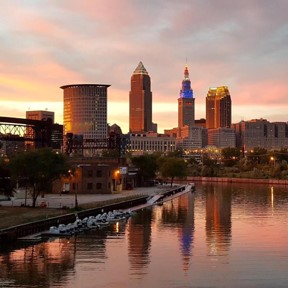It was a small fire, as fires go, and it wasn’t the first time that a river choked with industrial waste had burned. But a brief mention in Time Magazine in August, 1969 about burning fuel on the Cuyahoga River came to epitomize the sorry state of America’s environment in the years before the Clean Water Act and other seminal environmental legislation became law.
The fire on the Cuyahoga became “the emblem for all that was wrong with industrial America,” said environmental activist Denis Hayes yesterday, during a discussion at the Cleveland City Club. Hayes rose to prominence as an environmentalist in 1970 when he coordinated the first Earth Day event at the request of Wisconsin Senator Gaylord Nelson. That first Earth Day drew 20 million participants to rallies, protests and other environmental events across the nation.
Thanks to Time Magazine, the Cuyahoga River fire became widely known, said Hayes. But suggestions that it sparked the American environmental movement overstate the importance of the incident.
America’s patience with massive industrial pollution had already given out. Environmental groups had been working to reduce industrial pollution and had already made significant progress. An oil spill off Santa Barbara in January and February 1969 contaminated more than 200 miles of California coastline, highlighting the problem. The Cuyahoga River fire on June 19, 1969, though immortalized in Time, was just one more outrage.
But Time’s story, though brief, caught the public’s attention, said Hayes. “It was a teachable moment for Americans.”
It was not, however, the first time the Cuyahoga River had burned. Nor was it the most serious fire ever to occur on the river. Flammable liquids on the river had burned at least a dozen times previously, and a fire in 1912 had killed five people, according to researcher Doug Kusak. Industrial rivers in other cities had also suffered fires. But the myth that the 1969 Cuyahoga River fire led to the creation of the Environmental Protection Agency and major environmental legislation persists.
Regardless of the role the Cuyahoga River played in raising America’s environmental consciousness, since 1969 the nation has made great progress, said Hayes. He expects that the U.S. economy will continue to evolve from its past reliance on heavy industry to a more sustainable model that is less damaging to the environment.

The Cuyahoga River today. (photo: wvgirlinthe216)
But now we face new threats, including climate change, mass extinctions, and plastic loading in the oceans. These are international problems, said Hayes, and taking effective action internationally is much more difficult than taking action nationally.
We have already passed several tilting points, he said. No matter what we do now, hurricanes will continue to get stronger, extinct species will never come back, and ocean acidification will never be reversed.
While solving large-scale international problems, like climate change and mass extinctions, will require coordinated efforts by governments and industry, individuals can make a difference, said Hayes. Most importantly, individuals can take local action and demand effective action by their elected officials. “The real Earth Day is election day,” he said.
While supporters of environmental action might have science on their side, said Hayes, their opponents have been more motivated and more effective. People who support efforts to preserve and protect the environment must match the passion of these other groups. While Hayes does not believe that single-issue voting is appropriate, he said citizens concerned about the environment should make clear that candidates who do not understand the critical importance of environmental issues – including climate change – should not be considered qualified to serve.
Individuals can also make a difference through their purchasing decisions, said Hayes. Consumers should demand environmentally sound manufacturing processes, products, and packaging “There is one way our economy works,” he said, “when there is a demand for something, it tends to be produced.”
Despite the significant environmental problems facing us today, Hayes believes that positive change is possible, but will require international cooperation and collaboration and effective leadership by the United States. “Across the world, there are different solutions, different economies, different cultures, different problems,” he said. “We all need to come together.”
January 19, 2019
Burn on Big River
There’s a red moon rising
On the Cuyahoga River
Rolling into Cleveland to the lake
There’s a red moon rising
On the Cuyahoga River
Rolling into Cleveland to the lake
There’s an oil barge winding
Down the Cuyahoga River
Rolling into Cleveland to the lake
There’s an oil barge winding
Down the Cuyahoga River
Rolling into Cleveland to the lake
Cleveland city of light city of magic
Cleveland city of light you’re calling me
Cleveland, even now I can remember
Cause the Cuyahoga River
Goes smokin’ through my dreams
Burn on, big river, burn on
Burn on, big river, burn on
Now the Lord can make you tumble
And the Lord can make you turn
And the Lord can make you overflow
But the Lord can’t make you burn
Burn on, big river, burn on
Burn on, big river, burn on
Burn on Big River by Randy Newman
https://songmeanings.com/songs/view/37064/
For more information about the 1969 fire on the Cuyahoga River, see:
January 19, 2019
photo: Jim Ridge / Share the River
